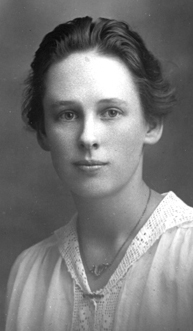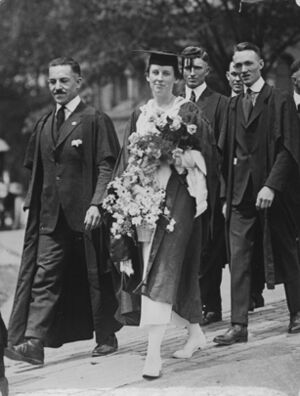Esther Hill facts for kids
Quick facts for kids
Esther Marjorie Hill
|
|
|---|---|

A studio portrait of Hill, taken between 1923 and 1928
|
|
| Born |
Esther Marjorie Hill
May 29, 1895 |
| Died | January 7, 1985 (aged 89) |
| Education | University of Toronto |
| Known for | Architecture |
Esther Marjorie Hill (born May 29, 1895 – died January 7, 1985) was a pioneering Canadian architect. She made history as the first woman to graduate with an architecture degree from the University of Toronto in 1920. Her journey was full of challenges, but she paved the way for many women in a field mostly dominated by men.
Early Life and Education
Esther Hill was born in Guelph, Ontario. Her father, E. Lincoln Hill, was a teacher and a librarian. Her mother, Jennie Stork Hill, was one of the first 10 women to study at the University of Toronto.
Esther first earned a Bachelor of Arts degree from the University of Alberta in 1916. She then started studying architecture at the same university. When that program was stopped, she moved to the University of Toronto. In 1920, she graduated, becoming the very first woman from the University of Toronto to get a university degree in architecture.
Career Challenges and Successes
Esther Hill faced many difficulties early in her career because she was a woman. Some men in the architecture business were not welcoming. This meant it was hard for her to find good job opportunities.
After graduating, her only job offer was as an interior designer at Eaton's department store. She later returned to Edmonton. In 1920 and 1921, she wrote articles for a journal called Agricultural Alberta. In these articles, she shared her ideas about designing homes. She believed in making houses practical and letting in lots of natural light.
She tried to join the Alberta Association of Architects, but her application was turned down. This might have been because she didn't have the required one year of experience. Despite these struggles, she found a job as a drafter at MacDonald and Magoon Architects in Edmonton.
In 1922, she began taking classes in urban planning at the University of Toronto. She then went to New York City to study at Columbia University. She also worked with other women architects there.
When she came back to Canada, she applied again to the Alberta Association of Architects. In 1925, Esther Hill became the first Canadian woman to be a registered architect. This was a huge achievement!
She went back to New York to work with another woman architect. But in 1928, she moved back to Edmonton. She still found it hard to get full-time work, even working part-time for MacDonald and Magoon. Things got even tougher when the Great Depression hit. To earn money, Hill did many different things. She taught, wove fabric, and made gloves and greeting cards.
In 1936, she moved to Victoria, British Columbia with her parents. After World War II, she started her own architectural firm. She also continued to weave, joining a local guild. She even won first prize for her weaving at the Canadian National Exhibition in 1942.
In 1953, she joined the Architectural Institute of British Columbia. She also served on the city planning committee for five years. She worked as an independent architect from her parents' home in Victoria. She designed houses, churches, apartment buildings, and retirement homes. She retired in 1963.
Esther Hill's work was special because she was "utterly alone" as a woman in the male-dominated world of architecture. She passed away in 1985. Some of her original drawings are kept at the Archives of the University of Toronto.
See also
 In Spanish: Esther Hill para niños
In Spanish: Esther Hill para niños


